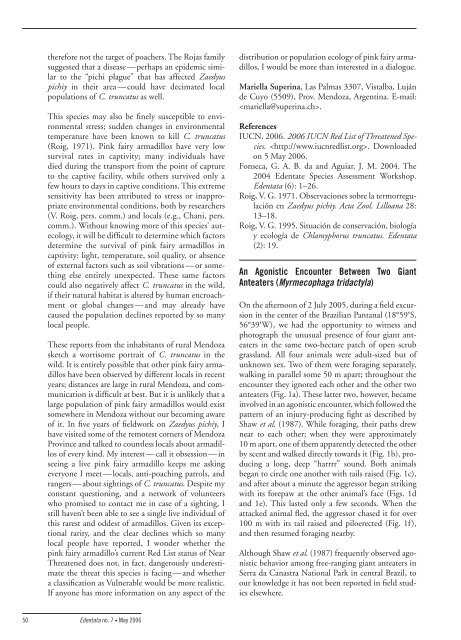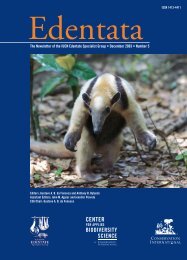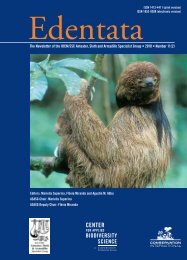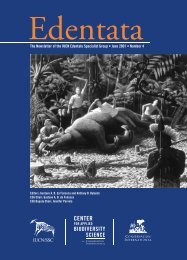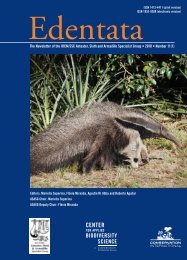Edentata 7 - Anteater, Sloth & Armadillo Specialist Group
Edentata 7 - Anteater, Sloth & Armadillo Specialist Group
Edentata 7 - Anteater, Sloth & Armadillo Specialist Group
- No tags were found...
Create successful ePaper yourself
Turn your PDF publications into a flip-book with our unique Google optimized e-Paper software.
therefore not the target of poachers. The Rojas family<br />
suggested that a disease — perhaps an epidemic similar<br />
to the “pichi plague” that has affected Zaedyus<br />
pichiy in their area — could have decimated local<br />
populations of C. truncatus as well.<br />
This species may also be finely susceptible to environmental<br />
stress; sudden changes in environmental<br />
temperature have been known to kill C. truncatus<br />
(Roig, 1971). Pink fairy armadillos have very low<br />
survival rates in captivity; many individuals have<br />
died during the transport from the point of capture<br />
to the captive facility, while others survived only a<br />
few hours to days in captive conditions. This extreme<br />
sensitivity has been attributed to stress or inappropriate<br />
environmental conditions, both by researchers<br />
(V. Roig, pers. comm.) and locals (e.g., Chani, pers.<br />
comm.). Without knowing more of this species’ autecology,<br />
it will be difficult to determine which factors<br />
determine the survival of pink fairy armadillos in<br />
captivity: light, temperature, soil quality, or absence<br />
of external factors such as soil vibrations — or something<br />
else entirely unexpected. These same factors<br />
could also negatively affect C. truncatus in the wild,<br />
if their natural habitat is altered by human encroachment<br />
or global changes — and may already have<br />
caused the population declines reported by so many<br />
local people.<br />
These reports from the inhabitants of rural Mendoza<br />
sketch a worrisome portrait of C. truncatus in the<br />
wild. It is entirely possible that other pink fairy armadillos<br />
have been observed by different locals in recent<br />
years; distances are large in rural Mendoza, and communication<br />
is difficult at best. But it is unlikely that a<br />
large population of pink fairy armadillos would exist<br />
somewhere in Mendoza without our becoming aware<br />
of it. In five years of fieldwork on Zaedyus pichiy, I<br />
have visited some of the remotest corners of Mendoza<br />
Province and talked to countless locals about armadillos<br />
of every kind. My interest — call it obsession — in<br />
seeing a live pink fairy armadillo keeps me asking<br />
everyone I meet — locals, anti-poaching patrols, and<br />
rangers — about sightings of C. truncatus. Despite my<br />
constant questioning, and a network of volunteers<br />
who promised to contact me in case of a sighting, I<br />
still haven’t been able to see a single live individual of<br />
this rarest and oddest of armadillos. Given its exceptional<br />
rarity, and the clear declines which so many<br />
local people have reported, I wonder whether the<br />
pink fairy armadillo’s current Red List status of Near<br />
Threatened does not, in fact, dangerously underestimate<br />
the threat this species is facing — and whether<br />
a classification as Vulnerable would be more realistic.<br />
If anyone has more information on any aspect of the<br />
distribution or population ecology of pink fairy armadillos,<br />
I would be more than interested in a dialogue.<br />
Mariella Superina, Las Palmas 3307, Vistalba, Luján<br />
de Cuyo (5509), Prov. Mendoza, Argentina. E-mail:<br />
.<br />
References<br />
IUCN. 2006. 2006 IUCN Red List of Threatened Species.<br />
. Downloaded<br />
on 5 May 2006.<br />
Fonseca, G. A. B. da and Aguiar, J. M. 2004. The<br />
2004 Edentate Species Assessment Workshop.<br />
<strong>Edentata</strong> (6): 1–26.<br />
Roig, V. G. 1971. Observaciones sobre la termorregulación<br />
en Zaedyus pichiy. Acta Zool. Lilloana 28:<br />
13–18.<br />
Roig, V. G. 1995. Situación de conservación, biología<br />
y ecología de Chlamyphorus truncatus. <strong>Edentata</strong><br />
(2): 19.<br />
An Agonistic Encounter Between Two Giant<br />
<strong>Anteater</strong>s (Myrmecophaga tridactyla)<br />
On the afternoon of 2 July 2005, during a field excursion<br />
in the center of the Brazilian Pantanal (18°59′S,<br />
56°39′W), we had the opportunity to witness and<br />
photograph the unusual presence of four giant anteaters<br />
in the same two-hectare patch of open scrub<br />
grassland. All four animals were adult-sized but of<br />
unknown sex. Two of them were foraging separately,<br />
walking in parallel some 50 m apart; throughout the<br />
encounter they ignored each other and the other two<br />
anteaters (Fig. 1a). These latter two, however, became<br />
involved in an agonistic encounter, which followed the<br />
pattern of an injury-producing fight as described by<br />
Shaw et al. (1987). While foraging, their paths drew<br />
near to each other; when they were approximately<br />
10 m apart, one of them apparently detected the other<br />
by scent and walked directly towards it (Fig. 1b), producing<br />
a long, deep “harrrr” sound. Both animals<br />
began to circle one another with tails raised (Fig. 1c),<br />
and after about a minute the aggressor began striking<br />
with its forepaw at the other animal’s face (Figs. 1d<br />
and 1e). This lasted only a few seconds. When the<br />
attacked animal fled, the aggressor chased it for over<br />
100 m with its tail raised and piloerected (Fig. 1f),<br />
and then resumed foraging nearby.<br />
Although Shaw et al. (1987) frequently observed agonistic<br />
behavior among free-ranging giant anteaters in<br />
Serra da Canastra National Park in central Brazil, to<br />
our knowledge it has not been reported in field studies<br />
elsewhere.<br />
50<br />
<strong>Edentata</strong> no. 7 • May 2006


